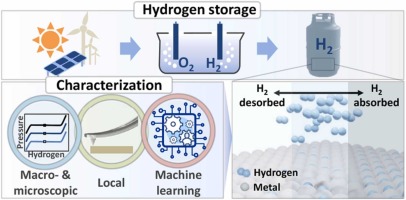In response to the rapidly growing global demand for hydrogen as a clean and sustainable energy carrier, the European Academy of Engineering (EAE) initiated a landmark research program in July 2024, aimed at developing next-generation hydrogen storage technologies. Hydrogen, with its capacity to produce zero emissions when used as a fuel, is increasingly recognized as a cornerstone in the global energy transition. However, its widespread adoption is hindered by significant challenges in efficient production, storage, and distribution. EAE's research seeks to address these challenges, focusing on improving hydrogen storage density, safety, and overall system efficiency to support the scale-up of hydrogen infrastructure across Europe and beyond.
The research initiative brings together leading experts from diverse fields such as materials science, chemical engineering, and energy systems engineering to explore innovative storage solutions. At the core of this effort is the investigation of advanced materials, including metal-organic frameworks (MOFs) and carbon-based materials, which show tremendous promise for enhancing hydrogen storage capacity. MOFs, with their high surface area and tunable pore structures, are particularly advantageous for storing hydrogen at lower pressures and higher densities. Meanwhile, carbon-based materials like graphene and nanotubes offer unique properties that can improve hydrogen adsorption and desorption processes, further enhancing the efficiency of hydrogen storage systems.
Key Research Areas:
-
Materials Innovation for Higher Storage Density: The central focus of the EAE research is the identification and development of novel materials capable of significantly increasing the energy density of hydrogen storage systems. Current hydrogen storage methods, such as compression and liquefaction, present several limitations, including high energy consumption and safety risks. By developing advanced storage materials, EAE aims to reduce the energy required for hydrogen storage and improve the safety and feasibility of storing large quantities of hydrogen, particularly for applications in transportation and industrial energy systems.
-
Cost-Effective and Safe Hydrogen Transportation: One of the major barriers to hydrogen’s broader adoption is the high cost and technical complexity of transporting hydrogen safely over long distances. EAE researchers are exploring solutions to facilitate the safe and economical transportation of hydrogen, with a focus on materials that allow for more compact and efficient storage, as well as reducing the risks associated with handling hydrogen under high pressures. These advancements are crucial for integrating hydrogen into existing energy distribution networks and for enabling its use in applications such as hydrogen-powered vehicles and industrial processes.
-
Hydrogen Storage for Renewable Energy Integration: Another vital aspect of the research is the role hydrogen storage can play in balancing the intermittency of renewable energy sources such as wind and solar power. By developing efficient hydrogen storage systems, EAE is helping to create pathways for storing excess renewable energy in the form of hydrogen, which can be used during periods of low generation or high demand. This approach not only enhances grid stability but also contributes to the long-term decarbonization of Europe’s energy system, aligning with the European Union’s goals of achieving carbon neutrality by 2050.
-
Scalability and Commercialization: Beyond laboratory research, EAE is committed to ensuring that these technologies are scalable and commercially viable. To this end, the research team is working closely with industry partners, governments, and other research institutions to test and refine these new storage systems in real-world settings. Pilot projects are being planned to demonstrate the feasibility of these advanced hydrogen storage solutions in sectors such as transportation, heavy industry, and power generation.
Strategic Impact:
The EAE’s research initiative is part of a broader European effort to transition to a hydrogen-based economy as a means of reducing dependence on fossil fuels and achieving long-term energy security. Hydrogen’s versatility as an energy carrier—capable of decarbonizing hard-to-electrify sectors such as heavy transport, aviation, and industrial processes—makes it a critical component of Europe’s energy future.
This research also aligns with the European Union’s Hydrogen Strategy, which aims to build a robust hydrogen infrastructure that spans production, storage, and distribution. By addressing the technical challenges of hydrogen storage, the EAE’s initiative is directly contributing to the EU’s long-term carbon neutrality goals. The outcomes of this research will play a crucial role in supporting the widespread adoption of hydrogen technologies across Europe, leading to cleaner energy systems, reduced greenhouse gas emissions, and the advancement of sustainable economic growth.
Conclusion:
The Advancing Hydrogen Storage Technologies for Sustainable Energy Systems project represents a significant step forward in the quest for a sustainable energy future. By tackling the critical challenges associated with hydrogen storage, EAE is paving the way for hydrogen to become a central pillar of the European energy landscape. Through materials innovation, interdisciplinary collaboration, and a focus on commercialization, this research not only supports Europe’s green energy transition but also strengthens its leadership in the global hydrogen economy. The insights and breakthroughs from this initiative will provide the technical foundation needed to unlock the full potential of hydrogen as a clean, safe, and reliable energy source for generations to come.
